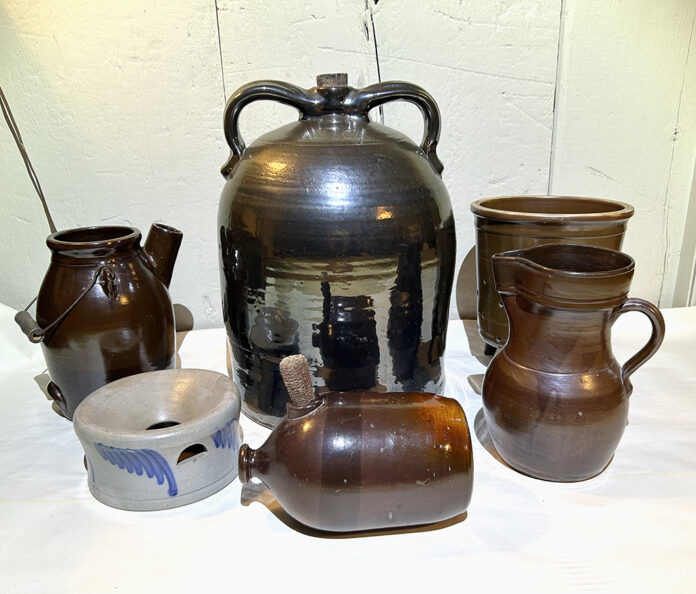
Aus von der erde,
Mit verstand,
Machs der heffner allerand.
— An old motto often inscribed on Pennsylvania German redware plates
“Out of the earth, with understanding, the potter makes all things.” It’s the translation from the German of the phrase quoted at the top of the story. What’s more, it couldn’t be truer. And that’s why the potter was considered the second most important craftsman — right behind the blacksmith — to recruit for a developing frontier community. With a lump of clay, a talented potter could indeed make darn near anything and everything, and there were plenty of items that were needed by residents of an embryonic town which they could not make themselves.
One of the things with which the Ohio Country was well blessed — besides almost endless forests — was rich deposits of clay left eons ago by glacial and other geologic activity. This clay — often referred to as “throwing clay” — which was found in astounding size deposits both above and below ground, proved ideal for the crafting of stoneware pottery.
Stoneware was a departure for the large percentage of German pioneers who migrated across the Appalachian and Alleghany Mountains from the southeastern Pennsylvania region where pottery items were made of redware. Those who came to the United States via the port of Philadelphia settled largely in the gently rolling hills to the west in the counties of Lancaster, Lebanon, Lehigh, Bucks, Berks and Montgomery. There they found red soils ideal for crafting almost the exact type of pottery they had known in their homeland. And thus, most of the articles of household pottery were of redware.
But what the Ohio Country lacked in terms of redware clay, it more than made up for in clay that was perfectly suited for the crafting of stoneware pottery, which wasn’t necessarily a bad thing at all. Redware pottery was actually quite soft and fragile, typically being low fired at a temperature around 700 degrees. Consequently, it did not ship well aboard wagons traveling over rough, primitive roads. Stoneware pottery, however, was far more durable, being high fired at about 1,200 degrees.
Although many German settlers brought along pieces of redware pottery from Pennsylvania, it didn’t take long for them to become cracked, chipped or broken with the rough day-to-day usage they received. Thus, the rapid establishment of potteries across this region of settlement became vitally important if the residents of the growing number of farms were going to have storage vessels in which to process and preserve foodstuffs, as well as have tableware and kitchenware.
As a result of this immediate need, great high-volume potteries quickly grew up and thrived along the Ohio River Valley, the Monongahela Valley in western Pennsylvania, West Virginia and the eastern portion of Ohio. Before the middle of the 19th century, the Monongahela Valley in West Virginia boasted nearly three dozen potteries including ones at Bridgeport, Clarksburg, Morgantown, Shinnston and Pruntytown. In the Ohio Valley, potteries flourished in Wheeling, Parkersburg and Wellsburg.
In western Pennsylvania, the discovery of what was considered to be the finest throwing clay in the world gave rise to huge pottery manufacturing operations in New Geneva and Greensboro. Other western Pennsylvania potteries were located in Johnstown, Fredericktown and West Brownsville.
In Ohio major pioneer pottery operations were established in East Liverpool, Cleveland, Akron, Mogadore, Middlebranch, Dalton, Doylestown, Wooster, Mount Eaton, Zoar, New Philadelphia and Orrville to supply the burgeoning needs of both the growing number of local farms and the nation’s massive western migration.
With the Ohio Country being a melting pot of both Pennsylvania German and New England cultures, pure pottery forms from both traditions were initially crafted here. But as time passed those styles melded and blended as each tradition learned from the other.

So what did the potters make? Well — as this tale started out — everything. Because they were needed immediately, the principle products were crocks, jugs and preserving jars of every size and description. These were made by the millions. Then there were huge two-handled jugs with spigots that were carried on wagons to slake the thirst of the workers in the field, and smaller thresherman’s (harvest) jugs which served the same purpose. The potters produced an endless stream of pitchers, butter churns, pie plates, batter jugs, water coolers, grease lamps, foot warmers, roof tiles, trivets, pipkins, water pipes, bulb starters, bee hives, bean pots, stovepipe collars, mortars and pestles, milk pans, doorstops, apple butter jars, tomato jars, spittoons, flowerpots, poultry waterers and even children’s toys and grave markers. Kitchen wares included everything from mixing bowls of every size and shape, Turk’s head molds for bunt cakes, meat tenderizers, butter stamps, storage cannisters, cake crocks, cookie jars and colanders. The list goes on almost ad infinitum. As a matter of fact, a potter in Zoar even made a large horn out of pottery with which to summon workers from the fields.
Like blacksmiths, potters were constantly called upon to use their imaginations to improvise products and create unique items which they had never even previously considered, and the best of them could do so without blinking an eye or missing a beat.
Production of the so-called “early” forms of American pottery peaked in the mid-19th century. Rising production and labor costs, coupled with changing technology that replaced traditional hand-throwing techniques with mechanical “jiggering,” altered the face of the craft forever. Its death knell came with the invention of methodology to manufacture cheap glass containers that put the great potteries of the Ohio Country out of business forever.












